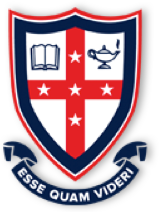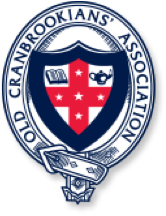Peter Kingston (OC 1960), Artist
Peter Kingston, or "Kingo" as he is known to his mates, arrived at Cranbrook in 1951 and graduated in 1960. He attended the classes of artist Justin O’Brien, who was Art Master at Cranbrook between 1946 and 1967 (see a profile here).
Fellow Cranbrookian and later a famous pop artist, Martin Sharp, crossed paths with "Kingo" in art class, although Sharp would graduate a year ahead of Kingston (see a profile of Sharp here).1 Martin Sharp would later describe the art room as a “sanctuary” that the Art Master created for his students; it was a “dynamic painting scene” that was so different to any other class that they didn’t even think of it as a class.2
After leaving Cranbrook, Peter Kingston went on to study architecture and arts at the University of New South Wales, graduating in 1965.
The bond forged at Cranbrook between Peter Kingston and Martin Sharp took a firmer hold during the 1960s, when Kingston was screening a short film at an architecture convention in the ballroom of the Australia Hotel. Martin and been walking past when Kingston saw him and invited him to come in and see the film.
The friendship rekindled from there, and it would soon also blossom into a continuing artistic partnership. When Martin Sharp opened artist collective “The Yellow House” in the early 1970s, for example, Kingston opened a tearoom in the backyard “so that visitors could sit and chat after experiencing the show".3 He also decorated the Stone Room, the Elephant House, created magic shows and performed.4
"Kingo" also became a cartoonist for the now infamous Oz magazine, for which Martin Sharp was art director. The magazine combined political and social journalism with satire and pop art, and it grabbed headlines with its modern and confrontational style, not least when its three leaders were arrested on an obscenity charge. But under the art directorship of Martin Sharp, and with contributions from artists like Peter Kingston, the magazine also set a new standard for graphic design in Australia. It was also able to showcase Australian talent overseas when the British version ran from the late 1960s through to the early 1970s.
In the 1970s, Kingston and Sharp collaborated again on a project to revitalise Sydney’s landmark Luna Park, which was then in danger of shutting its doors. Sharp and a group of artists including Kingston were commissioned to repaint many of the Park’s murals and ride façades.
Kingston has continued to be passionate about conserving treasured aspects of Sydney’s foreshore. This has included creating sculptural works along the Lavender Bay boardwalk where he lives, of characters from the works of Australian and New Zealand treasures such as May Gibbs, Dorothy Wall and Norman Lindsay. He has also made sculptural chess sets with similar themes, including one with pieces fashioned from historic rides at Luna Park and cartoon faces, which was featured in the Sydney Living Museums’ exhibition about Luna Park in 2015.
Also an illustrator and landscape painter, Peter Kingston has been exhibited at the Art Gallery of New South Wales, in the Dobell Drawing Prize between 1993 and 2000, in the Wynne Prize between 1995 and 2003, and in the Sulman Prize Prize between 1998 and 2001. His work is held by the National Gallery of Australia, the Art Gallery of New South Wales, the Museum of Sydney, and internationally in Belgium, Los Angeles and Tokyo.5 Harbourlights: the Art and Times of Peter Kingston, a book tracing the development of Kingston's art, was published in 2004.
The friendship between Sharp and "Kingo" was sustained until Sharp's death in 2013. Together they developed a set of boxed prints based on the portraits that Sharp had made as a Cranbrook schoolboy, and the boxes were covered in extracts from Sharp's old school reports.6
- 1. Recollections of the friendship and working relationship between Peter Kingston and Martin Sharp appear in Lowell Tarling, Sharp, 1942–1979: A Biography of Martin Sharp as Told to Lowell Tarling (Exile Bay: Ett Imprint, 2016).
- 2. This is Martin Sharp’s description, in ibid., p. 20.
- 3. Ibid., p. 145.
- 4. Joan Kerr and Olivia Bolton, “Peter Kingston, Biography”, Design and Art Australia Online, accessed online at https://www.daao.org.au/bio/peter-kingston/biography/, extracted on 22 February 2018.
- 5. “Peter Kingston”, Australian Galleries, accessed online at https://australiangalleries.com.au/artists/peter-kingston/, extracted 29 January 2018. International galleries include Bibliothèque de la Ville, Belgium; Costen Library, Los Angeles; and the National Film Library, Tokyo.
- 6. Joyce Morgan, “Interview: Martin Sharp”, The Sydney Morning Herald, 2 June 2012.

